In today’s competitive business landscape, entrepreneurs are constantly seeking innovative strategies to gain an edge. The blue sea strategy has emerged as a powerful approach, offering a fresh perspective on market creation and value innovation. This concept, closely related to the blue-ocean strategy, encourages businesses to explore uncharted territories and create new demand, rather than fighting for market share in existing, saturated markets.
At the end of this post, you can download our Blue Sea Strategy PowerPoint template to fit your purpose. As the same diagram PowerPoint template series, you can also find our 2025 Calendar with Holidays, The 7 Habits of Highly Effective People, Six Thinking Hats, Pareto Chart, Occam’s Razor, Data Mining, marketing segment, Porter’s five forces, SWOT Analysis, GE Matrix, BCG Matrix, Artificial Intelligence, National Diamond and BlockChain PowerPoint templates.
The Ultimate Guide to Blue Sea Strategy for Entrepreneurs delves into the core principles of this groundbreaking approach. It explores how companies can break free from traditional competition by focusing on strategic pricing, low cost operations, and enhancing customer value. The guide also examines the key differences between blue sea and red ocean strategies, providing real-world examples of successful implementations. By the end, readers will have a comprehensive understanding of how to apply these concepts to their own ventures, potentially transforming their business landscape.
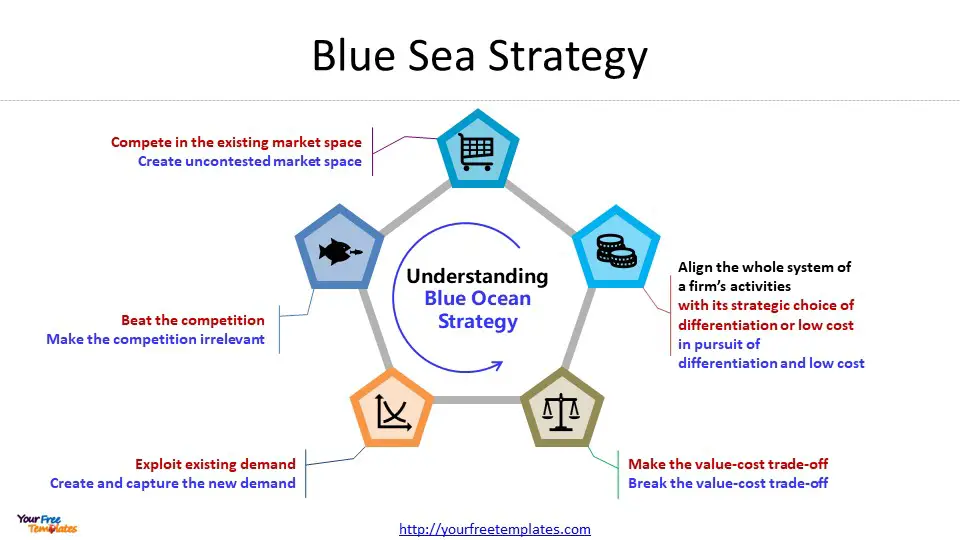
Understanding Blue Ocean Strategy
Definition and Core Concepts
Blue Ocean Strategy is an innovative approach to business that aims to create uncontested market space and make competition irrelevant 1. This strategy, introduced by INSEAD professors Chan Kim and Renee Mauborgne in their 2005 book, focuses on developing new industries or reimagining existing ones 2. The term “blue ocean” represents vast, untapped market opportunities, contrasting with the “red oceans” of existing, competitive industries 1.
The core concept of Blue Ocean Strategy is value innovation, which involves simultaneously pursuing differentiation and low costs 1. This approach challenges the conventional wisdom that companies must choose between providing superior value to customers at a higher cost or delivering reasonable value at a lower cost 3. Instead, Blue Ocean Strategy advocates for breaking this value-cost trade-off, allowing companies to offer increased value while reducing costs 3.
Difference from Red Ocean Strategy
Red Ocean Strategy represents the traditional approach to business, where companies compete in existing market spaces with well-defined industry boundaries 1. In red oceans, businesses focus on outperforming rivals and capturing a larger share of existing demand 1. This often results in a zero-sum game, where one company’s gain comes at the expense of another’s loss 1.
In contrast, Blue Ocean Strategy encourages companies to:
- Create uncontested market space
- Make competition irrelevant
- Create and capture new demand
- Break the value-cost trade-off
- Pursue both differentiation and low cost 3
While Red Ocean Strategy often leads to diminishing profits and limited growth opportunities, Blue Ocean Strategy offers the potential for rapid, profitable growth by tapping into new markets 2.
Key Principles of Blue Ocean Strategy
- Focus on the big picture: Instead of getting caught up in numbers and existing industry practices, Blue Ocean strategists concentrate on the overall strategic picture 3.
- Reach beyond existing demand: Companies should aim to create new demand rather than just compete for existing customers 1.
- Get the strategic sequence right: Blue Ocean Strategy emphasizes the importance of addressing buyer utility, price, cost, and adoption hurdles in the correct order 3.
- Overcome key organizational hurdles: Successful implementation of Blue Ocean Strategy requires overcoming cognitive, resource, motivational, and political hurdles within the organization 3.
- Build execution into strategy: The strategy should be developed with implementation in mind, ensuring that all stakeholders are aligned and committed to the new direction 3.
- Pursue differentiation and low cost simultaneously: This principle challenges the traditional notion that companies must choose between differentiation and cost leadership 1.
- Make the competition irrelevant: Instead of benchmarking against competitors, Blue Ocean strategists focus on creating a leap in value for both the company and its customers 3.
By adhering to these principles, companies can create blue oceans of uncontested market space, potentially leading to significant growth and profitability. It’s important to note that blue oceans can often be created from within existing industries, and they don’t necessarily require technological innovation 3. Instead, they involve linking existing technologies to what buyers truly value, thereby creating new market opportunities 3.
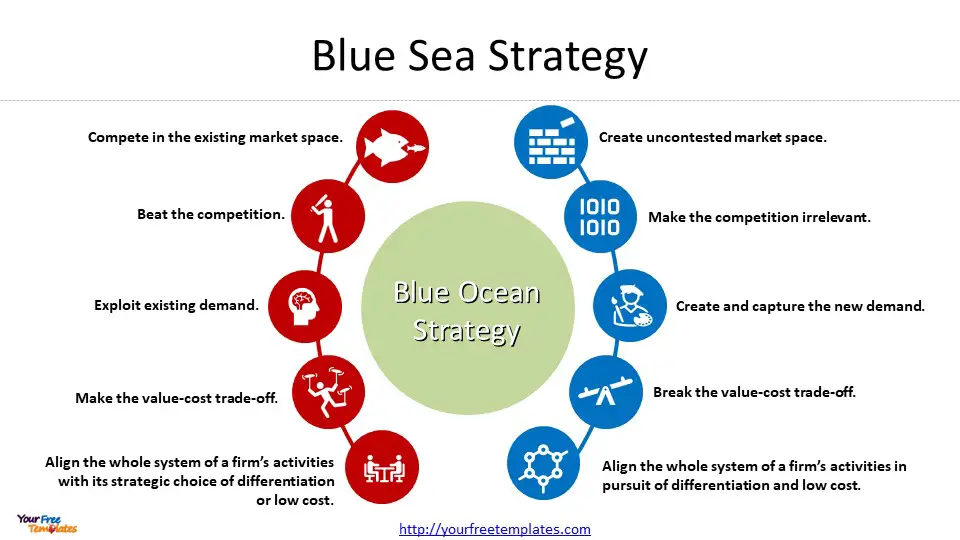
Creating Uncontested Market Space
Identifying Blue Oceans
Creating uncontested market space is at the heart of the blue ocean strategy. This approach involves looking beyond the conventional boundaries of competition to find new opportunities for growth and value creation 1. Instead of competing in overcrowded markets, companies seek to create and capture new demand, making competition irrelevant 1.
To identify blue oceans, companies can employ several strategies:
- Look across strategic groups: Companies can identify factors that determine buyers’ decisions to trade up or down from one group to another within an industry 1.
- Look across the chain of buyers: By targeting overlooked buyer groups, companies can uncover fresh innovation opportunities 1.
- Look across complementary products and services: Companies can seek untapped value hidden in other industries’ offerings that affect their own products’ value 1.
- Look across the functional-emotional orientation of an industry: Companies can challenge the conventional appeal of their industry, whether it’s based on utility and price or emotions and feelings 1.
Tools for Market Creation
To create new market space, companies can use several tools and approaches:
- Value Innovation: This concept involves simultaneously pursuing differentiation and low costs 1. It challenges the traditional notion that companies must choose between providing superior value at a higher cost or reasonable value at a lower cost 3.
- Four Actions Framework: This tool helps companies redesign their value curves by asking four key questions:
- What factors should be created that the industry has never offered?
- What factors should be eliminated that the industry has taken for granted?
- What factors should be raised well above the industry standard?
- What factors should be reduced well below the industry standard? 2
- Looking Across Substitute Industries: By examining substitute industries, companies can gain insights into redesigning their value curves to focus on previously overlooked customers 2.
- Redefining the Target Customer: Questioning conventional definitions of the target customer can lead to fundamentally new ways to create value 2.
- Focusing on Complements: Companies can create new market space by addressing the complements that detract from the value of their own products or services 2.
Overcoming Adoption Hurdles
Implementing a blue ocean strategy often requires overcoming several organizational hurdles:
- Cognitive Hurdle: Companies need to wake employees up to the need for a strategic shift 3. This can be achieved by making people experience harsh realities firsthand, such as meeting with disgruntled customers or witnessing operational problems 3.
- Resource Hurdle: Instead of seeking more resources, companies should focus on multiplying the value of existing resources 3. This involves identifying and redirecting resources from “cold spots” (high resource input, low performance impact) to “hot spots” (low resource input, high potential performance gains) 3.
- Motivational Hurdle: To motivate key players, companies should concentrate on “kingpins” – key influencers within the organization 3. Using “fishbowl management,” where kingpins’ actions are made highly visible, can drive sustained change 3.
- Political Hurdle: Companies need to identify and manage both supporters (“angels”) and detractors (“devils”) of the new strategy 3. Building coalitions with natural allies before potential conflicts arise can help isolate detractors and smooth the path for change 3.
By addressing these hurdles and employing the tools for market creation, companies can successfully implement blue ocean strategies and create uncontested market spaces. This approach allows them to break free from traditional competition and potentially achieve rapid, profitable growth 2.
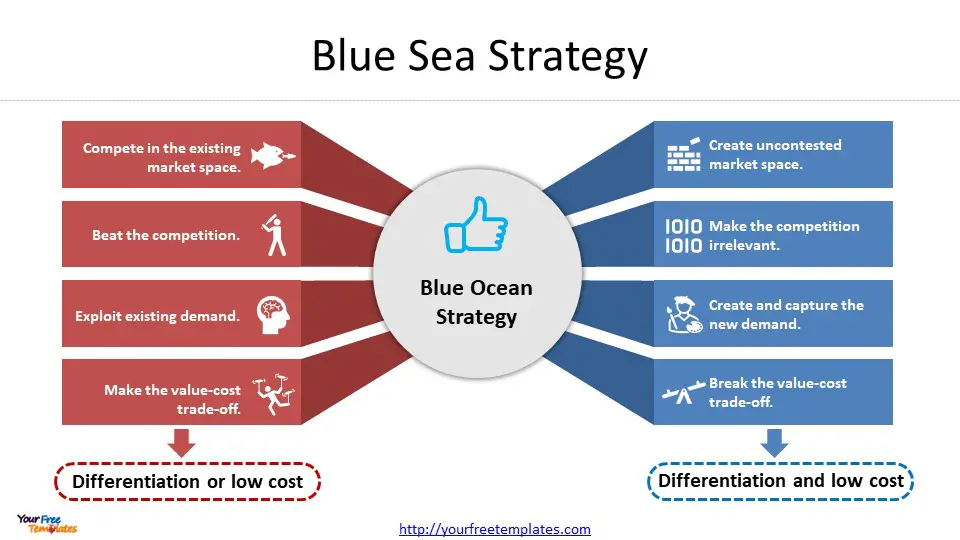
Implementing Blue Ocean Strategy
Four Actions Framework
The Four Actions Framework is a crucial tool in implementing Blue Ocean Strategy. Developed by Chan Kim and Renée Mauborgne, this framework helps companies challenge their industry’s strategic logic and business model 1. It consists of four key questions:
- Eliminate: Which factors that the industry takes for granted should be eliminated?
- Reduce: Which factors should be reduced well below the industry’s standard?
- Raise: Which factors should be raised well above the industry’s standard?
- Create: Which factors that the industry has never offered should be created? 1
This framework allows companies to systematically reconstruct buyer value elements across alternative industries, offering customers an entirely new experience while keeping costs low 1. To ensure simultaneous pursuit of differentiation and low cost, Kim and Mauborgne created the Eliminate-Reduce-Raise-Create (ERRC) grid, which complements the Four Actions Framework 1.
Strategy Canvas
The Strategy Canvas is a powerful visual tool that depicts how a business configures its offering to buyers in relation to its competitors 2. It serves as both a diagnostic tool and an action framework for building a compelling Blue Ocean Strategy 2. The Strategy Canvas captures:
- The current state of play in the known market space
- How businesses are currently competing and investing
- What buyers actually receive when they patronize the industry
- The strategic profiles or value curves of the company and major players 2
To create a Strategy Canvas:
- Determine who to compare against (direct competitors or offerings from other industries addressing the same customer needs)
- Choose comparison factors based on customer values and perspectives
- Evaluate products and services objectively, considering team discussions and customer feedback
- Define a strategy that differentiates from existing offerings 3
The horizontal axis of the Strategy Canvas shows key factors of competition, starting with price, while the vertical axis represents the offering level that buyers receive for each factor 2.
Executing the Blue Ocean Move
To successfully execute a Blue Ocean move, companies can follow a five-step process:
- Choose the right starting point and construct the appropriate Blue Ocean team
- Get clear about the current state of play
- Uncover hidden pain points limiting industry size and discover non-customers
- Systematically reconstruct market boundaries and develop alternative Blue Ocean opportunities
- Select the right Blue Ocean move, conduct rapid market tests, finalize, and launch the shift 4
To select the best Blue Ocean move, companies can host a Blue Ocean fair. This approach helps take politics out of the decision-making process, gather feedback, and consolidate people’s commitment to the chosen move .
Implementing Blue Ocean Strategy often requires overcoming organizational hurdles:
- Cognitive Hurdle: Wake employees up to the need for a strategic shift
- Resource Hurdle: Focus on multiplying the value of existing resources
- Motivational Hurdle: Motivate key players or “kingpins” within the organization
- Political Hurdle: Identify and manage supporters and detractors of the new strategy 1
By addressing these hurdles and following the systematic process outlined above, companies can successfully implement Blue Ocean Strategy, creating uncontested market spaces and achieving rapid, profitable growth.
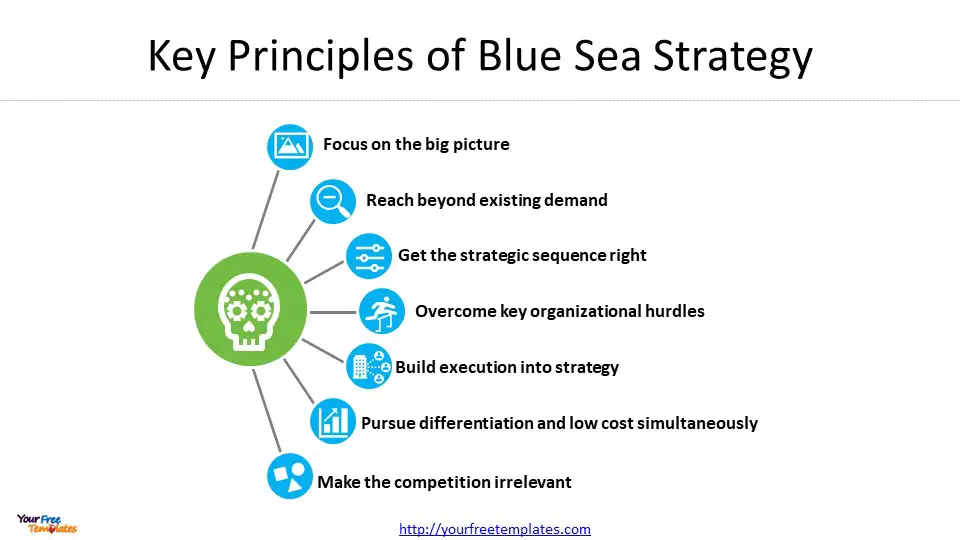
Case Studies of Successful Blue Ocean Strategies
Cirque du Soleil
Cirque du Soleil revolutionized the circus industry by creating a blue ocean of uncontested market space. In less than two decades, Cirque achieved revenue levels that took Ringling Bros. and Barnum & Bailey over a century to attain 1. The company’s productions have been witnessed by more than 150 million spectators in over 300 cities worldwide 1.
Cirque’s success is remarkable because it occurred in a declining industry with strong supplier power, increasing buyer power, and growing competition from alternative forms of entertainment 1. Instead of competing for existing customers, Cirque appealed to a new group: adults and corporate clients willing to pay premium prices for an unprecedented entertainment experience 1.
Cirque’s blue ocean strategy involved reinventing the circus concept. They eliminated traditional elements like animal shows and three-ring performances, which were costly and often controversial 2. Instead, they focused on three key factors: clowns, the tent, and classic acrobatic acts, while elevating the humor to a more sophisticated level 2.
Nintendo Wii
While there is no specific information provided about Nintendo Wii in the given factual keypoints, it is known that the Wii is another example of a successful blue ocean strategy. Nintendo created a new market space by focusing on casual gamers and families, rather than competing directly with other gaming consoles for hardcore gamers.
Yellow Tail wines
Yellow Tail, an Australian wine brand launched in 2001, exemplifies a successful blue ocean strategy in the wine industry 3. The brand created new demand by targeting non-wine drinkers, effectively expanding the market rather than competing for existing customers 3.
Yellow Tail’s strategy involved simplifying wine selection and creating an approachable product. They eliminated enological terminology and distinctions, reduced wine complexity and range, and created an easy-drinking, fun, and adventurous brand image 3. The company developed a soft, sweet wine without tannin and acid, appealing to consumers who typically didn’t drink wine 4.
The brand’s packaging was designed to be simple and unintimidating, featuring vibrant colors and minimal wine jargon 4. Yellow Tail focused on in-store promotions and wine-tasting events rather than traditional advertising 3.
As a result of this strategy, Yellow Tail sold 1 million bottles in the US in its first year, far exceeding the predicted 25,000 sales 3. In just two years, it became the fastest-growing brand in both the Australian and American wine industries and the number-one imported wine into the United States 3.
These case studies demonstrate how companies can create new market spaces and make competition irrelevant by challenging industry conventions and focusing on previously overlooked customer groups.
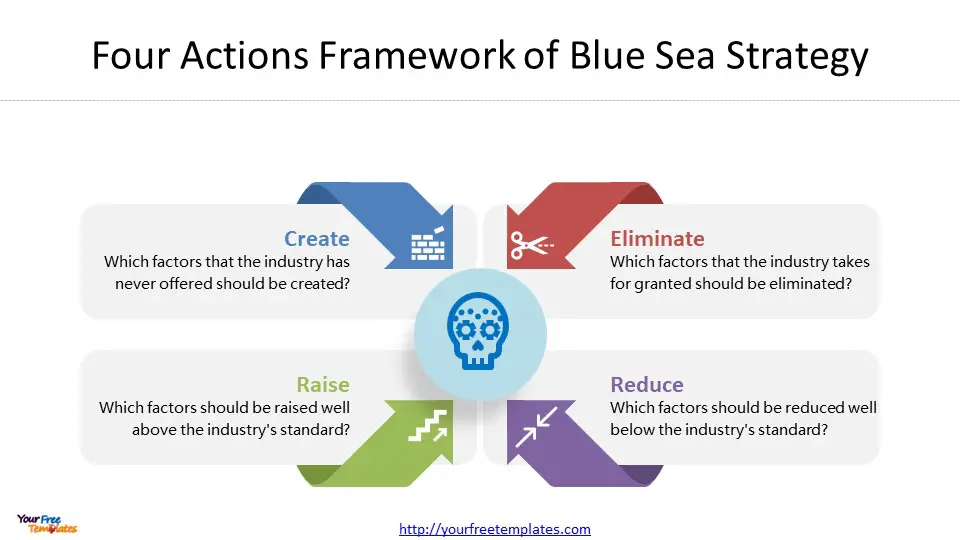
Conclusion
The Blue Ocean Strategy offers a groundbreaking approach to business, encouraging entrepreneurs to create uncontested market spaces rather than competing in existing ones. By focusing on value innovation, companies can simultaneously pursue differentiation and low costs, breaking free from traditional competition. This strategy has had a significant impact on various industries, as seen in the success stories of Cirque du Soleil, Nintendo Wii, and Yellow Tail wines.
To implement this strategy, businesses can use tools like the Four Actions Framework and Strategy Canvas to analyze and redefine their market approach. By addressing potential hurdles and following a systematic process, companies can execute their Blue Ocean move successfully. This approach not only allows businesses to tap into new markets but also has the potential to transform entire industries, leading to rapid and profitable growth.
FAQs
What exactly is the Blue Ocean Strategy in the context of entrepreneurship?
The Blue Ocean Strategy refers to the process of creating a new market space that is free from competition. Entrepreneurs focus on innovation to offer unique value propositions, thereby generating new demand and rendering existing competition irrelevant.
What are the essential elements required for a successful Blue Ocean Strategy?
Three critical elements form the foundation of a successful Blue Ocean Strategy: adopting a blue ocean mindset, utilizing effective tools and methodologies for creating new markets, and implementing a humanistic approach throughout the process.
Can you outline the six principles of the Blue Ocean Strategy?
The six guiding principles of the Blue Ocean Strategy involve exploring beyond the existing industry confines and include: examining alternative industries, investigating different strategic groups, targeting various buyer groups, considering complementary products and services, shifting between functional and emotional appeals, and evaluating trends over time.
What are the different types of Blue Ocean Strategies?
Blue Ocean Strategies can be categorized into six types, each focusing on different aspects of market creation: Industry, Head-to-Head Competition, Strategic Group, Buyer Group, Scope of Product or Service Offering, Functional-emotional Orientation, and Time. These categories help in identifying and exploring new, lucrative market spaces.
Need premium maps, pls visit our map shop: https://editablemaps.com
Size:355K
Type: PPTX
Blue Sea Strategy Template
Click the link to download it.
Aspect Ratio: Standard 4:3
Click the blue button to download it.
Download the 4:3 Template
Aspect Ratio: Widescreen 16:9
Click the green button to download it.
Download the 16:9 Template
References
[1] – https://hbr.org/2004/10/blue-ocean-strategy
[2] – https://www.blueoceanstrategy.com/what-is-blue-ocean-strategy/
[3] – https://www.businessnewsdaily.com/5647-blue-ocean-strategy.html
[4] – https://www.investopedia.com/terms/b/blue_ocean.asp














